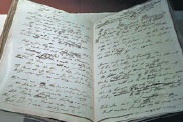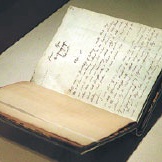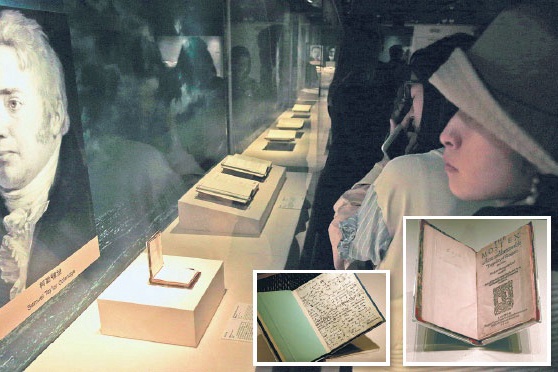An early edition of Romeo and Juliet is part of a stunning collection of treasures the British Library has brought to China. Mei Jia reports.
The 1599 quarto edition of Romeo and Juliet, once owned by King George III, is exceptionally rare: When it was printed, William Shakespeare was still alive and the play had already debuted. This version could well be the most accurate and closest to the Bard's original.
William Wordsworth's manuscript of his poem Daffodils includes handwritten notes the romantic master gave to the printer about where to place the verse.
Those are two of the 11 precious exhibits that are touring China for the first time, in a special exhibition of British literary masters - Shakespeare to Sherlock: Treasures of the British Library - at the National Library of China.
The exhibition, jointly organized by the national library and the British Library, runs through June 21.
"We chose works that are iconic in Britain, and are also known, liked and well-understood by Chinese," says Alexandra Ault, curator of the exhibition.
Her British Library colleague Jamie Andrews says: "We want to make a new partnership, a new friendship in China through culture and learning. There is no better way to do it than through English literature."
At the exhibition, the Shakespearean classic is shown side by side with a Ming Dynasty (1368-1644) copy of The Peony Pavilion, by the Bard's Chinese contemporary playwright Tang Xianzu.
Tessa Blackstone, chairman of the British Library Board, says she feels strong cultural links between the two countries, which "convey a sort of universality of literature", is a way of communicating our feelings, expressing our ideas and developing our humor or even creating tragedies.
The nine manuscripts and two early specimens of the British masters share the stage with 119 Chinese items, including key Chinese translations, adaptations and critical responses in categories of poetry, dramas and novels.
Lei Qiang, curator of the Chinese exhibits, is the one who suggested that a copy of Charles Dickens' David Copperfield be included in the exhibition because Chinese readers it know much better than the previously planned Nicholas Nickleby.
From the national library's rich collections, there are translations of Dickens' works by Lin Shu from the turn of the 20th century, as well as works by writers like Lao She, who has been influenced by Dickens' depiction of people of various social status.
Lei says the exhibition also borrows from the Jiaxing Library in Zhejiang province: the manuscripts of celebrated scholar Zhu Shenghao, who translated more than 30 of the Bard's works.
"English literature brought many new thoughts to the forerunners of modern Chinese literature," says Lu Jiande, director of the Chinese Literature Institute of the Chinese Academy of Social Sciences.
Blackstone is impressed by Zhu's contribution during his short life, and she is even more surprised to find how Sherlock Holmes, the famous detective created by Arthur Conan Doyle, is popular in China.
So manuscripts by Doyle are on show, revealing the neat and precise handwriting from which sprang his enticing novels.
So are Ian Fleming's ball-penned drafts in which James Bond was born.
The exhibition is the first project of The British Library in China, a three-year China-UK cultural exchange program.
The team is planning four more exhibitions in cities like Wuzhen, Shanghai and Hong Kong through 2019. Focusing on literature, each show will bring different exhibits.
Li Honglin, deputy director of the national library, says Chinese and British libraries' cooperation expands the tradition of China-UK culture-sharing work.
Andrews, meanwhile, notes that amid the British Library's 150-million-item collection, in addition to having every book published in the UK, newspaper, journal, magazine and website, there is a very strong historical record of Chinese material. Curators make sure they collect contemporary Chinese literature as well.
A goal of the ongoing collaboration with China, he says, is to find out more about contemporary Chinese writers.
"To be able to read them, understand them, and to be able to relate the contemporary tradition of Chinese writing to the historical ones," he says.
For his part, Lei appreciates the way the British Library, as a public library, operates professional exhibitions - and the level of digitalization of its sea of collections.
"The National Library of China is doing well in this respect, but there are inspirations we get and things we can learn from our partners," Lei says.
Blackstone says she hopes to receive more Chinese visitors to the British Library, which was once frequented by Karl Marx and Dickens.
A new Chinese-language site, www.britishlibrary.cn, has also been launched, offering high-definition pictures that allow viewers to zoom-in for details of its collections.
Contact the writer at meijia@chinadaily.com.cn
If you go
Shakespeare to Sherlock: Treasures of the British Library
9 am-5 pm, Tuesday to Sunday, through June 21. National Museum of Classic Books, National Library of China, Haidian district, Beijing.
010-8854-4747.
Of characters, notes and names
Though hundreds of years have passed, writers' early manuscripts breathe life into literary classics even as they bear witness to the passage of time. Some of the highlights of the ongoing exhibition Shakespeare to Sherlock: Treasures of the British Library :

Don Juan
George Gordon Byron
1822
The limping poet successfully turns Don Juan from a seducer to someone who falls in love in his 16,000-line, unfinished poem. "He turns the story (original play plot) upside-down and he surprises us," says Alexandra Ault, curator of the exhibition.
Byron's manuscripts are on different-sized sheets of paper, and we can actually see him making changes and crossing out lines. The paper shows traces of being folded, indicating how Byron carried them with him and wrote using what was available to him.
"The folds reveal the artistic process of the poet," says Ault.
The Rime of the Ancient Mariner
Samuel Taylor Coleridge
1806
Coleridge's famous poem lays the foundation for the Romantic Movement, which is characterized by a focus on nature and the sublime, with highs and lows of feeling, and the supernatural.
He preferred to write in a handy notebook. The British Library holds 55 of the 72 Coleridge notebooks in existence.

Jane Eyre
Charlotte Bronte
1847
A widely read novel in China, Ault says the work is generally considered to be the first example of the modern novel, because of its characterization and narrative.
"There is so much depth in terms of the object, the story and the author," she says.
On show at the National Library of China is a fair copy of the book.
"It's the copy that was sent to Bronte's publisher and finally launched her career, and it thus changed the way British read and understand novels," says Ault.
Printers' fingerprints are visible, as well as Bronte's pen name, Currer Bell, which is crossed out. "Bronte felt that the male pseudonym would give her novels more credibility," the display's notes say, revealing the limited social status of women writers at the time.
Mei Jia





